If ever you've doubted the potential of an electric car to entertain the driver, if ever you've questioned how we'll continue to enjoy driving in a fuel-less future, I have an answer for you. It's the Jaguar I-Pace.
Jaguar has taken both a massive risk and a massive lead over its German (and one American) rivals, by getting the I-Pace to the market early. While Audi, BMW and Mercedes are just now showing off their first electric SUVs, with sales still some months away, the I-Pace is on the road and in dealerships right now.
Well, mostly it is. You may struggle to actually get your hands on one, as the I-Pace is built for Jaguar on contract by Magna-Steyr, in Austria. Such has been the pre-launch publicity for the car, and so unsure were Jaguar’s product-planning people as to how many might actually sell, that demand does seem to be over-running supply at the moment.
What is it that people are clamouring for? Well, the I-Pace is a compact SUV. Very compact, in fact. While the Audi e-Tron and Mercedes EQC are very definitely tall, high-roofed SUVs, the I-Pace seems a little lower slung, more at the meeting point between hatchback, estate and crossover. It’s … nice? Honestly, I’m still a little unsure. There’s a pleasing chunkiness to the styling, and the Coke-bottle swoosh in the window line gives it a touch of 1970s glamour, but it’s a combination of shape and marque that still takes a little while to get your head around.
It’s certainly aerodynamically efficient. A co-efficient of drag of just 0.29cd is impressive, and thanks to the bespoke aluminium chassis, which packages its large 90kWh battery in the floor, the I-Pace is able to package a wheelbase the same as that of the XF saloon, in an overall length barely any greater than that of the compact XE four-door.
The cabin is something of a triumph. We’ve criticised Jaguar’s cabin design in recent years for being too plain, verging on the bland, but somehow the I-Pace takes the same basic ingredients and makes them into a nicer whole. As you’d expect, the interior is dominated by electronic screens: two big ones each for the main infotainment screen and the instrument panel, and a smaller, lower one that takes car of air-conditioning and some supplementary controls. Thankfully, Jaguar has left some separate short-cut buttons for such things as demisting and the volume knob for the radio.
Invitingly tactile
You sit, very comfortably and slightly reclined and back from the dashboard, and the small three-spoke steering wheel feels invitingly tactile in your hands. The main instrument screen does the usual flicks and backflips as you get the layout set up to your taste, but it must be said that the steering wheel controls – a mixture of touch-sensitive pads and physical buttons – make the process a touch more fiddly than it ought to be.
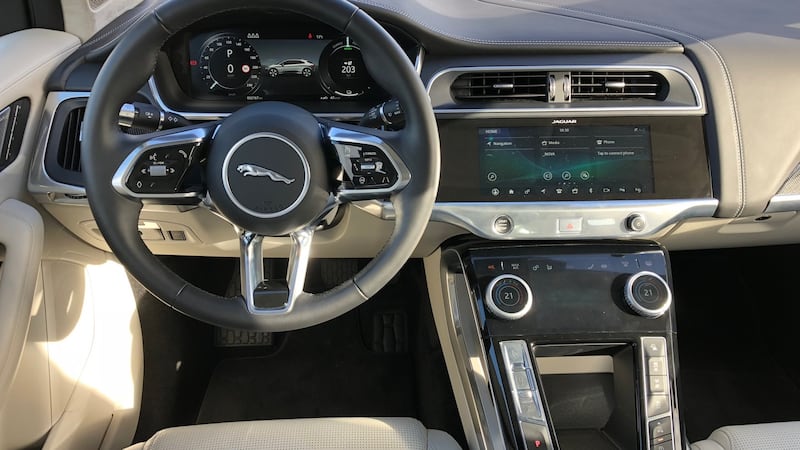
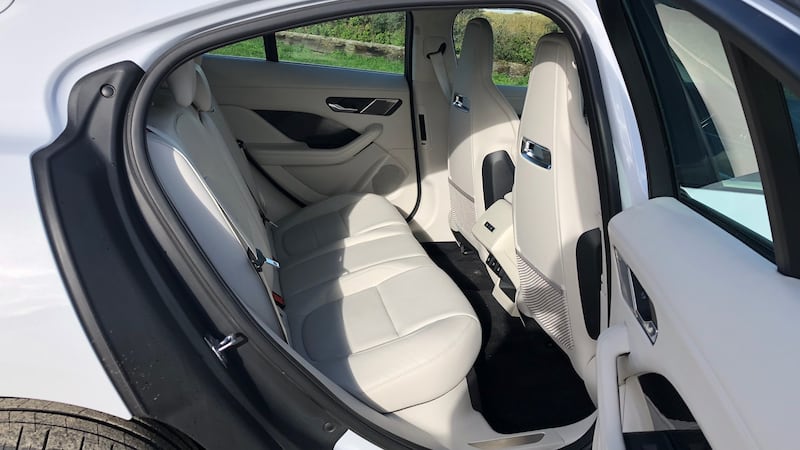
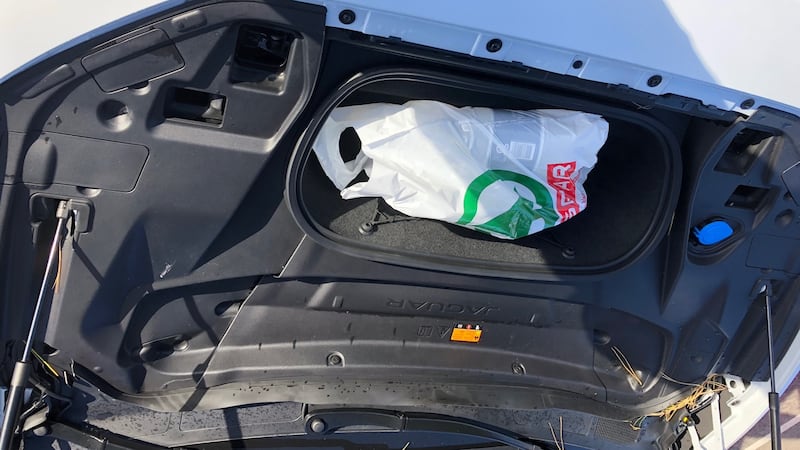
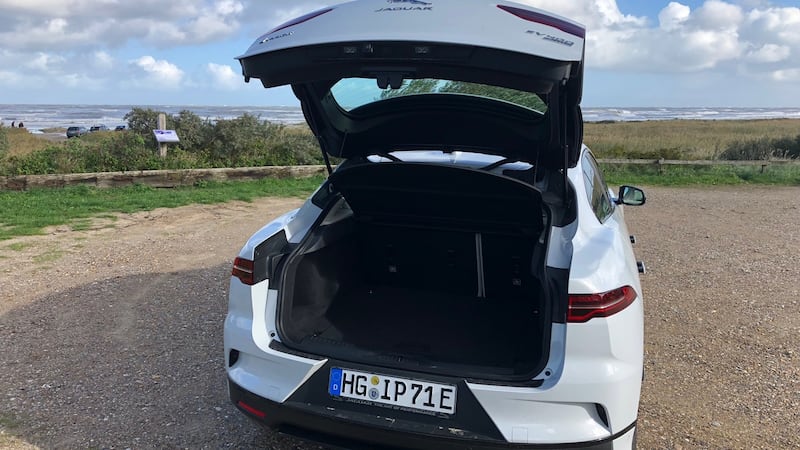
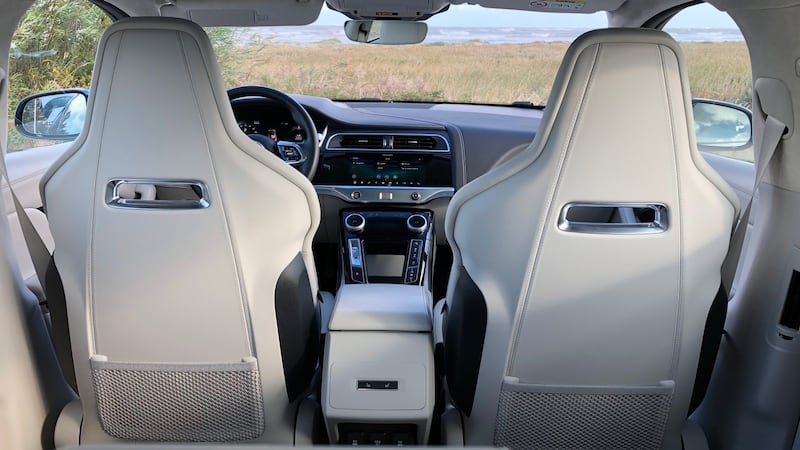
Space is … reasonable, but sadly nothing more. Perhaps Jaguar should have been a touch bolder and stretched out the wheelbase more to create an airier cabin? Maybe, but there is compensation in a good 656-litre boot, and a small auxiliary 27-litre “frunk” storage bay under the stubby bonnet.
Mounted at either end of the battery stack are two electric motors, which together develop 400hp and and give the I-Pace four-wheel drive. There’s also a distinctly healthy 696Nm of torque. Step on the throttle pedal from standstill or low speeds and the I-Pace pins you, hard, back into the seat with its initial acceleration. It doesn’t have the ‘Ludicrous Mode’ of the Tesla Model X 90D, and the quoted 0-100km/h time is more than a second-and-a-half slower, at 4.8secs, but subjectively it feels rapid enough to bring on uncontrolled giggles. In fact, your first few kilometres in an I-Pace are likely to be a series of surges and lunges as you explore the delicious combination of torque and traction.
That’s the first few kilometres, but what about the long hauls? Well, under the WLTP emissions and range tests, Jaguar quotes a one-charge range of 470km, which is very healthy indeed. Now, as ever such claims have to be taken with a pinch of salt, although it’s worth pointing out that we all-but matched Jaguar’s average energy consumption figure, of 21.2kWh per 100km, with an indicated consumption in very mixed driving of 22kWh per 100km.
350km range
What will you actually get? We only had the car, loaned to us by Belfast-based dealer Charles Hurst, for a bare 24 hours, so there wasn’t enough time to do a full-to-empty-to-full cycle, but based on what we observed, I reckon that the I-Pace will pretty safely go for 350km-380km between charges. You could potentially stretch that figure further by being a little more economical in your driving style, or using the air-conditioning a little less (although the climate control is clever enough to recognise when individual seats are occupied and alter the air flow accordingly). On the motorway, you’ll do much worse, of course, as is the case with all electric cars. Sticking a finger in the air, I’d say you’ll get just under 200km from a full charge if you’re cruising at 120km/h all day.
That sounds limiting, but frankly if range concerns tempt you off the motorway and on to a twistier road, all well and good. The I-Pace is one of the first electric cars that can truly thrill on a good road. The chassis set-up, overseen by Jaguar’s magic-handed dynamics expert Mike Cross, is exceptionally good. The I-Pace has a lot of weight to control, more than 2.2 tons empty, so the ride quality is predictably firm.
Thankfully, it’s also well-damped so you don’t generally feel uncomfortable. The payback for the firmness is body control, and thanks in part to the low centre of gravity that comes with having the batteries in the floor, the I-Pace corners flatly and neatly. The steering doesn’t have especially good feedback, but its weighting is delectable, and thanks to the way the electric motors parcel out the torque, the I-Pace swooshes into and out of corners with remarkable agility for something this heavy and this broad across the shoulders. It is, in a word, fun. Or, if you like, it’s an electric car that drives like a proper Jaguar.
Downsides
Flaws? When you’re pushing hard on a twisty road, occasionally the way the nose responds to steering inputs can feel a bit odd, as if the inertia of the electric motor is having an effect on proceedings (although it must be said you have to be trying pretty hard to cause this), and while there’s the delightful refinement of having no reciprocating engine on board, there is a good bit of tyre noise from those big, handsome alloy wheels.
Then there’s the quality. The I-Pace almost, almost, got a perfect score here. In general, it feels much, much better-built than the Tesla Model X, and even with the silence of the electric motors, there was not a single audible squeak or rattle from the cabin, even when driving over very poor surfaces (not something we can say about the more expensive Tesla). The whole car, to its very structure, feels impressively solid and stiff, and right up until we dropped the car back, it was putting in a perfect quality performance. And then, at the last minute, on the last journey, the big touchscreen in the centre of the dash went dark. The system was till working (we were still listening to the radio and able to work the controls on the lower screen) but it took a stop-lock-unlock-restart cycle to waken the big screen again. A small glitch, but a potentially annoying one. It followed an earlier problem with an I-Pace test car, where an air-con pump consistently hissed and gasped like an asthmatic chainsmoker.
Prices for the I-Pace start at €86,585 once you’ve had your SEAI grant, and our SE-spec test car boosts that to €95,880 with an extra €1,165 for the gorgeous Firenze Red paint job. Not cheap, then, although it does undercut the larger, more spacious, multi-seat Tesla.
It is a remarkable car, though, and possibly the first electric vehicle that I’ve actually desired ownership of on other than eco-friendly grounds. Fast, fun, sure-footed, and intriguing to look at. If Jaguar can iron out the small quality issues, then there’s the potential for a massive hit here.
Many thanks to Charles Hurst Belfast for their help with this feature
THE LOWDOWN
Jaguar I-Pace P400 SE
Price as tested: €97,045 (prices start at €86,585)
Power: 400hp.
Torque: 696Nm.
0-100kmh: 4.8sec.
Top speed: 200km/h.
Range & consumption: 470km (21kWh per 100km).
CO2 emissions: 0g/km.
Motor tax: €120.
Verdict: Potentially the best electric car you can buy right now, even if it is very expensive.
Our rating: 4/5









